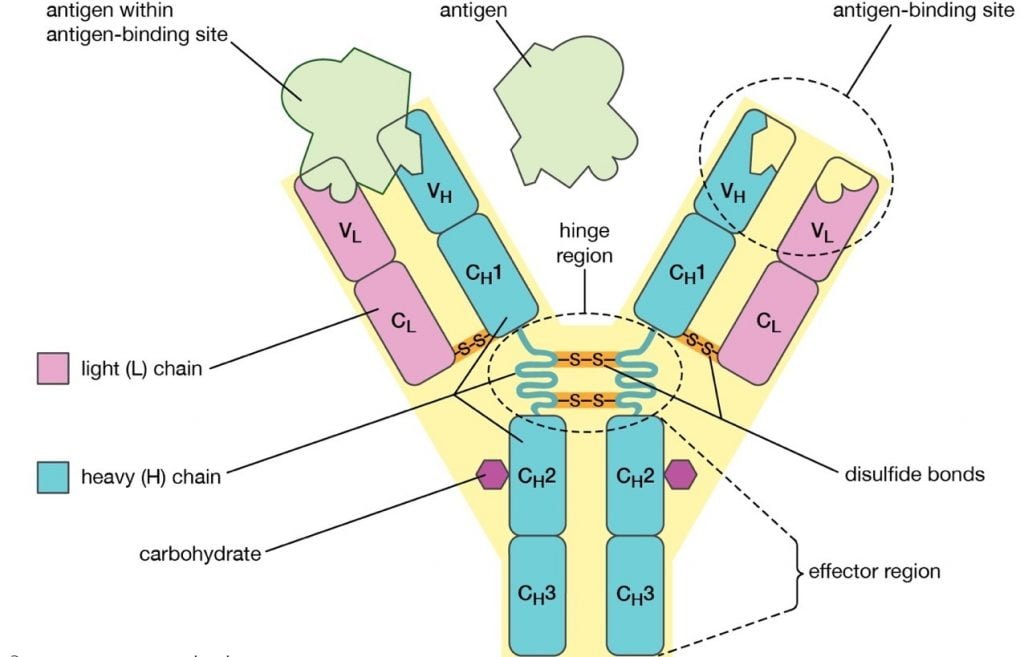Introduction
- Antibodies (also called immunoglobulins) are the glycoproteins produced by the immune system of the host in response to the entry of foreign molecules into the body.
- The foreign molecules are referred to as antigens and their recognition by the immune system results in selective production of antibodies which will bind to the particular antigen present on the invading bacteria or virus particles (pathogen), eliminating it from the body.
History of Antibody Discovery:
Emil von Behring and Shibasaburo Kitasato in 1890 showed that the transfer of serum from animals immunized against diphtheria to animals infected from it could cure the affected animals 1. Later in 1901, Behring was awarded the first Nobel Prize in medicine for his work on “serum therapy” 1. In 1900, Paul Ehrlich, one of the fathers of modern immunology, proposed the side-chain theory, where he hypothesized the existence of distinct membrane-related structures that can interact with extracellular molecules 2. He was the first to propose a model for an antibody molecule wherein the antibodies are branched and consist of multiple sites for binding antigens, and the activation of the classical complement pathway 3. The model was similar to the “lock and key” hypothesis proposed by Emil Fischer for enzymes 4.
Structure of an antibody

- An antibody is Y-shaped and is composed of four polypeptides, two heavy chains, and two light chains, identical, joined together by disulfide bonds.
- There are five types of the heavy chains, termed gamma (γ), mu (μ), alpha (α), delta (δ), and epsilon (ε), and two types of light chains, lambda (λ) and kappa (κ)5.
- The combination of heavy and light chains gives heterogeneity to antibodies.
- The Y-shaped structure allows antibody molecules to carry out the antigen-binding activity and effector function, carried out by different parts: fragment antigen-binding (Fab) and fragment crystallizable (Fc) regions.
- Fab fragment binds to the antigen and is composed of constant and variable domains, each of the heavy and the light chains. These domains, together form the antigen-binding site (paratope) that is specific for one particular epitope of an antigen.
- Fc region, the tail region of an antibody, interacts with receptors expressed on the cell surface, Fc receptors, and proteins of the complement system for the initiation of the immune response 6.
Classification of antibodies:
Based on the amino acid sequence of a constant region of the heavy chain, antibodies are divided into five classes 7.
- IgG: Four subclasses-IgG1, IgG2, IgG3, IgG4
- IgA: Two subclasses-IgA1, IgA2
- IgM
- IgD
- IgE

Figure source: https://microbiologyinfo.com/antibody-structure-classes-and-functions/
B cell activation and production of antibodies:
Antibodies are produced by activated B cells. Antibody secreting B cell is called a plasma cell. Binding of B cell receptor (BCR) to an antigen, either soluble or membrane-bound, triggers the activation of B cell. Activation can be either T-cell independent or T-cell dependent.
T cell-independent activation:
Similar antigens cause cross-linkage of BCRs expressed on the surface of B cells. It leads to the production of IgM/IgD by short-lived plasma cells. Memory B cells do not seem to be produced when B cell is activated, independent of T cell.
T cell-dependent activation:
APCs (Antigen-presenting cells) process and present protein antigens on MHC (Major histocompatibility complex) class II molecule to the helper T cells. Cytokines secreted from activated helper T cells activate B cells and plasma cells that produce different classes of antibodies: IgG, IgA, IgE, as a result of class switching or retain IgM. Cytokines produced by T cells and other cells are important in determining what type of antibody the B cells express. Memory B cells are also produced, which can recognize and rapidly respond to secondary exposure to the same antigen.

Functions of antibodies:
The antibodies have three main functions:
- Neutralization: Antibody participating in a neutralization reaction is called a neutralizing antibody. The neutralizing antibody binds to the antigen, preventing the attachment of pathogen to host tissues 8.
- Opsonization/phagocytosis: Antibody participating in the opsonization reaction is called opsonin. Opsonin forms complex with an antigen, which in turn is engulfed by phagocytic cells. Opsonin acts as a mark/stamp for phagocytosis.
- Complement fixation: It is a system of many small proteins, once activated or triggered, leads to the formation of membrane attack complex. Immune complexes (antigen-antibody complexes) initiates the activation of the classical complement pathway 9.

References
- Kantha SS. (1991). A Centennial Review; the 1890 Tetanus Antitoxin Paper of von Behring and Kitasato and the Related Developments. Keio J Med, 40(1), 35-39. doi:10.2302/kjm.40.35
- Valent P, Groner B, Schumacher U, et al. (2016). Paul Ehrlich (1854-1915) and His Contributions to the Foundation and Birth of Translational Medicine. J Innate Immun, 8(2), 111-120. doi:10.1159/000443526
- Davies DR, Chacko S. (1993). Antibody structure. Acc Chem Res, 26(8), 421-427. doi:10.1021/ar00032a005
- Lemieux RU, Spohr U. (1994). How Emil Fischer was led to the lock and key concept for enzyme specificity. Adv Carbohydr Chem Biochem, 50, 1-20.
- Chiu ML, Goulet DR, Teplyakov A, Gilliland GL. (2019). Antibody Structure and Function: The Basis for Engineering Therapeutics. Antibodies (Basel, Switzerland), 8(4), 55. doi:10.3390/antib8040055
- Möller G, Svehag S-E. (1972). Specificity of lymphocyte-mediated cytotoxicity induced by in vitro antibody-coated target cells. Cell Immunol, 4(1), 1-19. doi:https://doi.org/10.1016/0008-8749(72)90001-9
- Schroeder Jr HW, Cavacini L. (2010). Structure and function of immunoglobulins. J Allergy Clin Immunol, 125(2 Suppl 2), S41-S52. doi:10.1016/j.jaci.2009.09.046
- Forthal DN. (2014). Functions of Antibodies. Microbiol Spectr, 2(4), 1-17. https://pubmed.ncbi.nlm.nih.gov/25215264.
- Walport MJ. (2001). Complement. First of two parts. N Engl J Med, 344(14), 1058-1066. doi:10.1056/NEJM200104053441406